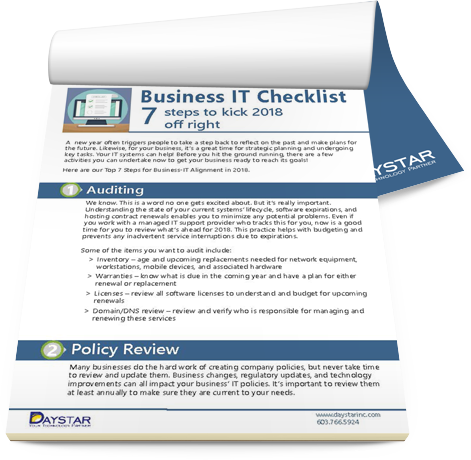It’s all happening! You’ve finally signed onto managed IT services, and you are preparing for the transition. What steps can you take to make the shift to managed remote IT support as seamless as possible? How do you prepare your team for the change? As Daystar’s network administrator responsible for onboarding new managed clients, these are questions I’m regularly faced with, and helping our clients settle into their new services is always a priority. Read on for some guiding principles that will set your team up for success with your new IT provider.
Make yourself (and your network!) available
While our ultimate goal as a managed services provider is to drastically reduce your team’s administrative IT overhead, there is one exception to the rule: the onboard process. Onboarding refers to the procedures and tasks undertaken to transfer your IT support to a new provider. There is a vast amount of information that needs to change hands, especially in today’s age, when IT is the bedrock upon which most successful businesses have been built for decades. The more information you can provide, and the more engaged you are in the transition, the better we’ll understand your teams, your workflow, and your network. During this critical time, it’s important to be available.
As the architect of our onboarding process, I fully understand how overwhelming it can be to sit down and answer question after question regarding largely esoteric systems. Nevertheless, I assure you that the better we understand your environment during the onboarding period, the more successful our teams will be in helping you take full advantage of technology moving forward. And we’re not just talking about knowledge here – help make every device and every piece of infrastructure available, as well. I always appreciate being told about your remote office in Newark, NJ, or your failover VMware cluster in the cloud at the beginning of the onboard, rather than the end.
Be honest; ask questions
During the onboard, as we install our tools, document your infrastructure, and pick your brain about your workflow, if there is something you don’t understand, or simply don’t know, tell us! There are very likely skeletons in your IT closet, and we need your help cleaning them out. Keeping them buried only makes for ghosts in the machine. This is a judgement free zone – however self-conscious you might be about your staff’s technical aptitude, or your production server that hasn’t been updated since the Y2K scare, we promise never to make you feel small or foolish. Those days of IT are over – information is key here, and if you don’t know or don’t understand, tell us, and we’ll figure it out together. Likewise, if you don’t understand a line of questioning or why we’re installing Toolset A on Server B, ask. The more you understand about the systems we’re putting in place, the smoother the transition and subsequent support will be.
Do your homework
While it might be tempting to kick back, pour yourself a well-earned beverage of choice, and watch the sun set on the days of unmitigated IT disasters, there’s one final step to ensuring a positive transition: take the time to fully understand your new support resources. Let’s break this down into a few categories:
- Services
Familiarize yourself with the components of your managed services package. It’s important to know that you have unlimited remote support hours and unlimited onsite hours – no more checking the clock, or seeing how long you can live with a problem before submitting a ticket! Oh, and those cloud backups? You have unlimited storage up there, too. Curious about the tiered anti-malware strategy deployed in your environment? That’s always good knowledge to have in your back pocket for vendors and auditors. Having a good understanding of the services your new provider is contracted to provide means you know exactly what you can depend on moving forward. - Expectations
While you’re making your way through the fine print of your newly inked contract, take a moment to review your service level agreements (SLAs) with key personnel, so support response expectations are properly set. Response times and ticket priorities might be changing significantly from your in-house or previously outsourced IT, so it’s important to make sure your staff’s expectations are properly aligned to prevent a rocky first few weeks. - Human Resources
Acquaint yourself with your new resources and their roles. Have a question about implementing a new piece of software or the risk in giving a vendor remote access to network resources? Shoot your network admin an email. Want to compliment a technician on a job well done, or request a sit-down to discuss the current state of things? Call your account manager/client relations. While we provide our clients with a single point of contact for any question under the sun, understanding who your advocates are on the IT side, and their new role in working with your organization, goes a long way. - Methods of Contact
Workflow changes always accompany a change in IT providers, so making sure everyone knows how to use the new ticketing system, when to pick up the phone and call in an issue, and which email address you can use to automatically generate a ticket are important steps in ensuring that staff actually receive the support we’re happy to provide. Daystar likes to provide a communications flowchart to elucidate the new methods of contact.
I can hear everyone’s collective sigh of relief as you realize that none my recommendations for a smooth transition into managed services are technical in nature. Far from it, in fact – they hinge on communication, understanding, and due diligence. Making sure you’re actively engaged in the process of changing providers, and taking the time to make sure your team understands the new resources at their disposal is, in my experience, enough to grease the wheels and get the new relationship humming along nicely.
















